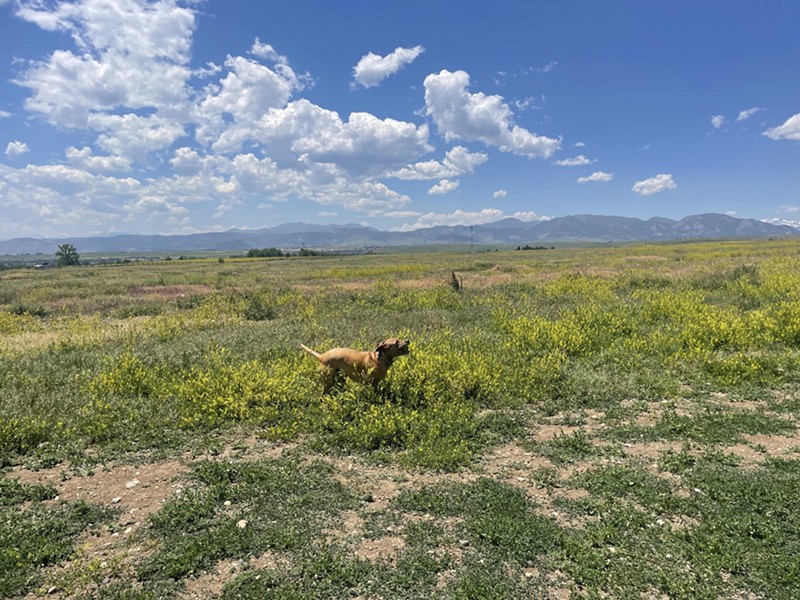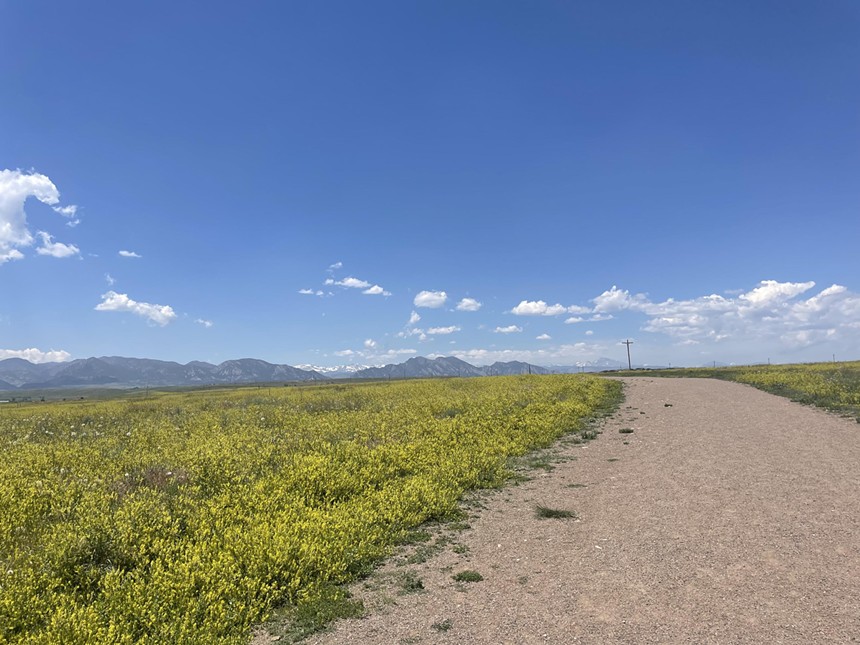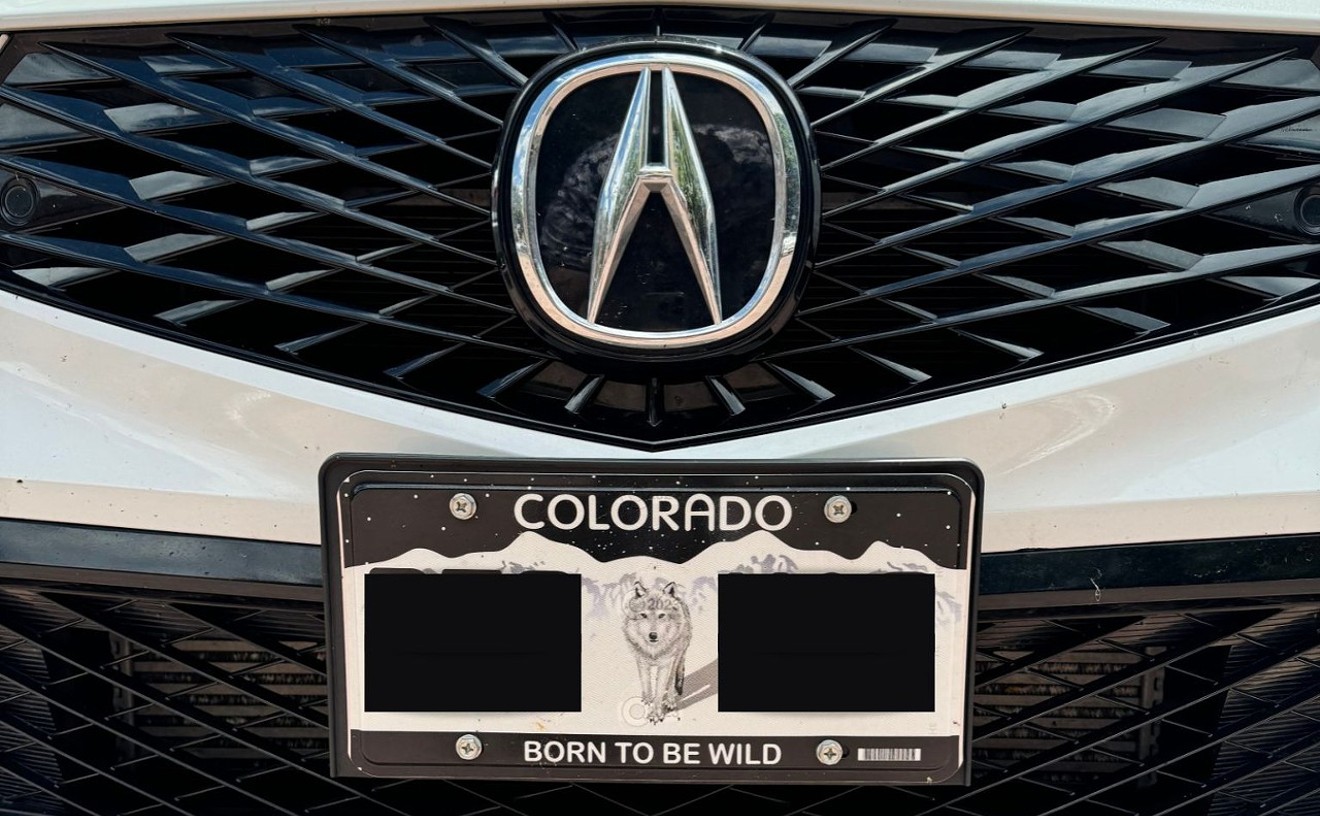Still, some city officials and residents believe it’s high time the city stopped letting overuse and neglect ruin the prairie landscape.
“It's an incredible piece of land that's connected to 100,000 acres of preserved open space,” says Tomás Herrera-Mishler, Westminster’s director of Parks, Recreation, and Libraries (PRL). “It's remnants of the shortgrass prairie. It's the most threatened ecosystem in the world. We're losing it more quickly than the Amazon rainforest, so it's an ecologically very important ecosystem — and it's beautiful.”
Herrera-Mishler says the city proposed curtailing off-leash dog access to all but around 33 acres of Westminster Hills in order to to preserve and rebuild the native prairie ecosystem. He sees the city’s role as being stewards of the land.
“When you get out there, you're going to see the happiest dogs on the planet, no question about it,” he says. “I'm actually a huge fan of dogs and pets in general, but I do think that we need to really look at the scale of what we're doing out there and think carefully.”
The Westy Dog Park Guardians is a 300-plus-member advocacy group that formed earlier this year with the goal of convincing Westminster to keep the 470 acres of open space open. According to its members, most of whom are dog owners, the benefits of the wide-open space are vital.
“We have a really good crew that really loves this location, and it’s worth fighting for,” says Andrew Guthrie, a member of the Guardians and a longtime Westminster resident. “To be able to meet their dogs and say how cute they are and give them some pets and see the other dogs’ excitement, it just creates an instant bond with other members of the community.”
However, some who live near the park say that vibrant community has made the park feel exclusive to dog owners.
“My mental health has been negatively impacted for the last six years due to this destruction,” Tanya O’Conner, who has lived across the street from the open space for thirty years, said at a June 10 Westminster City Council meeting. “I am a daily walker and runner in this area, and I used to run in the dog park, but have been chased by out-of-control dogs, so I no longer do so. ... If I want to enjoy the view of the mountains, I'm also reminded of the sad state of the area.”
Westminster Hills Open Space History
The City of Westminster has owned the land since 1988, when it was used primarily for cattle grazing. Over the next several decades, the city added 600 acres to the land, resulting in more than 1,000 acres of open space.In the early 2000s, PRL opened up 27 acres as an off-leash dog area. These areas differ from dog parks because they are not fenced off and designated just for dog use. Rather, off-leash activity is allowed to mix with other recreational uses.
In 2008, Westminster expanded off-leash dog access to the entire 1,000-acre site, but a bubonic plague outbreak quickly forced the city to close off the area until 2010, when it reopened the 470 acres that are in use now.
In 2017, Westminster joined the Rocky Mountain Greenway, a trail system designed to connect the Rocky Mountain Arsenal to Rocky Mountain National Park. Westminster then added an extra parking lot to the site; Herrera-Mishler says that caused the popularity of the land to grow exponentially.
PRL estimates that in the past year, a minimum of 750,000 people have visited the space. According to Herrera-Mishler, the department has expanded the parking lot six times to accommodate the extra interest in Westminster Hills, but illegal parking in the neighborhood nearby has been a consistent problem.
In 2014, PRL created a stewardship plan for all open spaces, with a stated goal to make them places for passive recreation like walking or nature photography — and where the parks director could permit active uses like off-leash activity as long as it didn’t damage the natural environment.
According to Herrera-Mishler, that’s the problem at Westminster Hills: Pet urine has made the soil too high in nitrogen for many native species. Since 2014, the city has worked hard to eliminate all Class A invasive plants from the land. It succeeded, but still needs to get rid of lower-level invasive plants.
Because the land was set aside for cows to graze, it was never designed for recreation with proper trails, causing social or volunteer trails to pop up without structure or proper space in between trails for plants to live.
“It was never fully, intentionally laid out to provide people with a variety of choices,” Herrera-Mishler says. “Some people can walk and walk and walk for hours, and other people, they've got half an hour to 45 minutes.”
He says research has shown that off-leash dogs have a 250-foot impact zone on either side of a trail. At Westminster Hills, there is an estimated 55 acres of unaffected habitat using that measure.
Proposals to Preserve Space for Off-Leash Dogs
PRL hired an environmental firm to figure out how to maximize the opportunities for prairie habitat. The firm suggested decreasing the size of the dog park to 33 acres — but when PRL asked for public feedback, the department quickly realized how much people care. Although the first meeting last November didn’t attract too many people, 250 showed up to the session in January. By March, a meeting was so packed that the fire marshal had to turn people away because the meeting space was at its 325-person capacity.
“The volume around the issue had been turned up considerably, and the emotions,” Herrera-Mishler says.
The Guardians have a volunteer team out every weekend to inform people about the proposed changes and to ask them to be better stewards of the land by picking up extra dog waste and being mindful of others. Guthrie came across the group in January when he took his dog Greta to the open space, which he does often.
Exposing dogs to new smells and letting them run is important for their health, he says, and the variety of trails at Westminster Hills provide that.
Because Herrera-Mishler heard from so many people like Guthrie, he formed a community advisory team for neighbors, park users, dog owners and environmentalists to all have a voice. Guthrie was one of the community representatives.
The team came up with three recommendations for how to proceed: Leave the space unchanged aside from investing more in active management; leave a 200-acre off-leash dog area; or leave a 110-acre off-leash dog area. The city also maintained its original 33-acre suggestion.
Any option other than the 33-acre choice would still leave Westminster Hills as the largest off-leash dog area in metro Denver. The next-largest, Cherry Creek State Park, has around seventy acres.
On June 3, PRL presented the four options to city councilmembers at a study session. For its part, the council was largely critical of the group for not reaching a consensus. Councilmembers also questioned why the parks staff had allowed the situation to get to this point in the first place. The contentious discussion lasted for hours.
The Guardians were also upset with PRL. The dog advocates alleged that PRL staff took up all but three seats in the room for the study session. Herrera-Mishler says that his staff “really surprised him” by showing up in those numbers; it wasn’t a planned effort to exclude citizens, he explains, but rather a showing of passion from the employees.
Additionally, the Guardians were upset that the 33-acre plan was still presented despite pushback from the advisory team, including members who weren't considered dog lovers. The council did not seem to be amenable to the 33-acre suggestion, anyway.
Councilmembers also asked PRL to dive into fiscal impacts of the suggested plans.
A 2014 plan called for the city to spend $1,700 per acre of open space annually on management, but PRL's current budget only allocates about $550, according to Herrera-Mishler. Additionally, the plan suggested that there be one open-space steward per 600 aces, but the PRL currently has so few rangers that each is maintaining 1,200 acres.
One suggestion from the Guardians was a Voice and Sight Program, like one in Boulder where dogs can be off-leash on designated trails if the owners have proven their and their pooches’ ability to respond to commands and behave. Guthrie and Greta are enrolled in that program and have paid its fees, but Herrera-Mishler says Westminster doesn’t have the capacity to implement a similar program.
“It's very expensive to administer a program like that,” he says. “They have five people that are assigned to that program in Boulder.”
City council also asked PRL to look into charging for parking or charging non-residents an annual use fee as a way to generate revenue that could help with open-space management — and deter some users to help with capacity issues.
“What we're worried about is that that will drive people — haha, joke — into the neighborhood to park,” Herrera-Mishler says.
Councilmember Claire Carmelia and Mayor Pro Tem Sarah Nurmela said they were interested in the possibility of closing off at least 100 acres and leaving another 300 open for recreation; most members of the council voted to direct PRL to dive into the option of leaving the entire space open for recreation moving forward.
“Thank you to them for listening to what the vast majority of citizens want,” Guthrie says in response to the council's decision.
Dog Owners Don't Speak for All of Westminster
Not everyone in town agrees with the Guardians' outlook. At the June 10 council meeting, several commenters criticized the members for what they saw as disrespectful conduct toward city staff during the study session. Members of the advisory team joined in to say that they felt the process hadn’t been represented fairly by the council.Melissa Koss, a facilitation professional who was on the advisory team, argued that facilitation is about getting all ideas out and making sure an issue is examined thoroughly, which she believed occurred. She said she has been coming to city council for eight years about the parking problems and other safety issues at the open space, and doesn't necessarily agree with the dog-first approach.
“It is the crown jewel of Westminster, period, and it deserves to be taken better care of than it is right now,” Koss said. “I'm going to ask you to please push for a town hall, because the voices you're hearing don't actually represent the city. They're the loudest, but they're not the best-informed.”
Bethany Yaffe, a sustainability professional who was on the advisory team, said she can no longer use the space because her dog was attacked there. She pointed out that the advisory team all agreed that more management and trail design was needed.
“I'm asking city council to re-engage with city staff and other experts in this field with the professionalism that they deserve to learn why they did not recommend option one,” Yaffe said.
Guardians and other supporters of keeping much of the land open to off-leash dogs also chimed in, reiterating their desire to partner with the city to help maintain and restore the open space.
“This is our rec center,” Beth McBride told the council. “The park is a promenade for dogs with strollers, dogs with toddlers, dogs with grandparents, dogs with relatives — and bikers with dogs, runners with dogs, seniors with dogs, and those whose dogs have passed and they just come around to the dog park because they want to talk, pet dogs and talk to these people.”
A public meeting has been tentatively scheduled for June 20 but has not been made official. On June 24, PRL is set to return with more details about converting the open space land to park land, budget concerns and an overall management vision.













